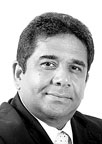Financial indicators show Seylan's stablity -CEO
by Gamini WARUSHAMANA
Despite high interest rates, core banking activities are increasing
and have contributed a major share to Seylan Bank's profits, said the
CEO of Seylan Bank, Kapila Ariyaratne. Interest rates have gone up and
the Rupee has depreciated and these factors have a negative impact on
business activities. People need time to adjust to new conditions, he
said in an interview with the Sunday Observer.
 |
|
Kapila Ariyaratne |
Following are excerpts of the interview:
In 2008, Seylan Bank fell into crisis after the collapse of Golden
Key Credit Card Company and crisis in the Ceylinco Group. The confidence
the people had in the Bank suffered and customers started to pull their
money out. The Bank had the ability to pay and the Central Bank and the
Government intervened and recapitalised the Bank.
Today government institutions hold a large stake in Seylan Bank. Sri
Lanka Insurance and the Bank of Ceylon hold 30 percent Seylan shares,
while LOLC and Browns account for 25 percent. Today Seylan is
independent of the Ceylinco group and has regained its glory and rebuilt
the confidence of its customers.
The Bank is strong and all indicators show our stability. Our capital
adequacy ratio is 14 percent, well ahead of the statutory requirement of
10 percent.
The NPL ratio is continuously declining from 30 percent in 2009 to 14
percent in 2012. Some of the non-performing loans include the loans
given to mega projects and property development such as Hyatt Regency
and we hope to recover them at a compensation tribunal. Our ratings too
have improved from BBB+ last year to A - this year.
A strategic plan for 2012-2015 is in operation with focus on the
customer, new product development and value addition and it has begun to
show results. After tax profit of Seylan Bank for the first half of the
year was Rs. 1.02b compared to Rs. 1b for 2011.
Our half-year profit has exceeded the achievements of the whole of
last year. Growth came mainly from our core banking activities. Capital
gains and equity market activities were sluggish during the period.
Deposits, advances, trade financing, foreign remittances and credit
cards were the main source of profit.
During the first half of this year advances grew by 19 percent and
deposits by 18 percent and net interest income increased by 15 percent
to Rs. 4,276m. Non-interest income increased from Rs. 1,171m to Rs.
1,237 million during the period. Foreign exchange income grew by 20
percent in the first half of the year against the corresponding period
last year. We have confidence in maintaining this growth momentum.
"We have a human resource development plan focused on skills
development of the staff and on risk management. We focused on the
control of overhead costs by improving cost efficiency and as a result
the cost to income ratio improved to 67 percent, a reduction of six
percent in the first six months of the year."
"There are opportunities in the economy and there is a demand for
credit from SMEs, agriculture, fisheries and trade sectors. "
"We are strong in these segments and have planned to launch new
products for them. New strategies will be implemented to provide a
better service for expatriate workers including expansion of our
presence overseas."
"Last year the Bank expanded its branch network opening new branches
in the North, the East and other regions. Today we have 137 branches and
another ten will be added during this year."
"Our focus today is building customer confidence and we have seen
success in this regard. Banking is all about confidence. Our staffers
had to work hard to build customer confidence after the crisis we faced
in 2008. Despite the intensively competitive environment the deposit
base of the Bank grew by Rs. 10.3b."
"The Seylan rights issue of Rs. 4.6 b in 2011 was oversubscribed and
this year we expect to go for a debenture issue of Rs.1b with the
expectation to increase it to Rs. 2b to further improve our capital
base."
"At the same time it will enable us to strengthen our lending
portfolio. The negotiations we had with multilateral agencies and
international banks on long-term financing to strengthen our tier two
capital were successful," he said.
|


